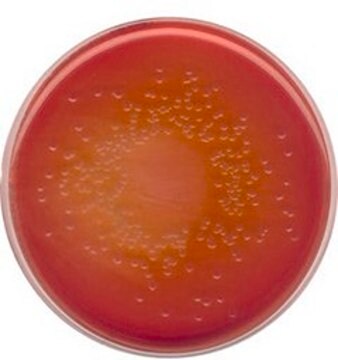69965
Mossel Broth
suitable for microbiology, NutriSelect® Basic
Synonym(s):
Buffered Glucose-Brilliant Green Bile Broth, EE Broth, Enterobacteriaceae Enrichment Broth acc. to Mossel
About This Item
Recommended Products
sterility
non-sterile
Quality Level
form
powder
shelf life
limited shelf life, expiry date on the label
composition
brilliant green, 0.015 g/L
disodium hydrogen phosphate, 6.45 g/L
glucose, 5 g/L
ox-bile, 20 g/L
peptone, 10 g/L
potassium dihydrogen phosphate, 2 g/L
manufacturer/tradename
NutriSelect® Basic
technique(s)
microbiological culture: suitable
final pH
7.2±0.2 (20 °C)
application(s)
agriculture
bioburden testing
environmental
food and beverages
water monitoring
microbiology
suitability
selective for Citrobacter spp.
selective for Enterococcus spp.
selective for Escherichia coli
selective for Klebsiella spp.
selective for Proteus spp.
selective for Salmonella spp.
selective for Shigella spp.
selective for Yersinia spp.
selective for coliforms
selective for enterobacteriaceae
Application
Preparation Note
Other Notes
Footnote
The designations basic, plus, or prime are added to indicate the quality control level, from basic quality control to standard QC plus to prime for full regulatory compliance.
Legal Information
Hazard Statements
Precautionary Statements
Hazard Classifications
Aquatic Chronic 3
Storage Class Code
11 - Combustible Solids
WGK
WGK 3
Flash Point(F)
Not applicable
Flash Point(C)
Not applicable
Personal Protective Equipment
Choose from one of the most recent versions:
Already Own This Product?
Find documentation for the products that you have recently purchased in the Document Library.
Customers Also Viewed
Articles
Chronobacter spp. Classic and New Detection Methods
Salmonella contamination is the second leading cause of food-borne illness worldwide. Controlling outbreaks of Salmonella is an important task for food regulators, restaurants and the food industry in general. The Salmonella family includes over 2,300 serotypes of bacteria, but two types, Salmonella enteritidis and Salmonella typhimurium, are responsible for about half of all human infections. Most outbreaks of Salmonella are traced back to dairy, poultry and meat products, but Salmonella can grow on nearly any food. Chicken, eggs and their derivative products are particularly high risk.
Protocols
General guidance for the detection and enumeration of Enterobacteriaceae in food according to EN-ISO 8523:1991 and EN-ISO 4832:1991, respectively.
Our team of scientists has experience in all areas of research including Life Science, Material Science, Chemical Synthesis, Chromatography, Analytical and many others.
Contact Technical Service
